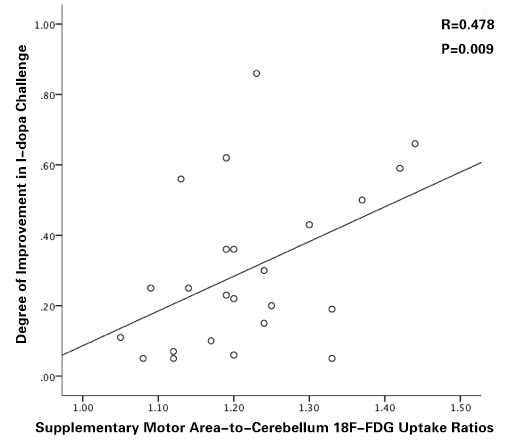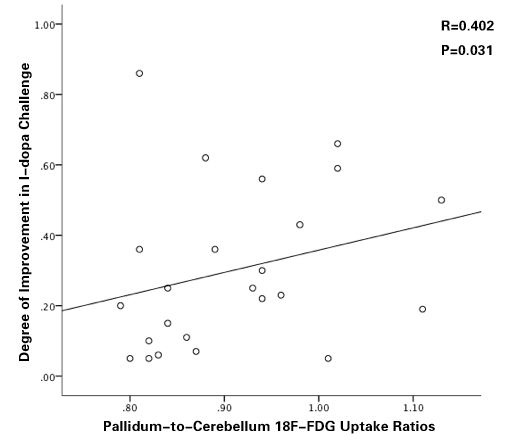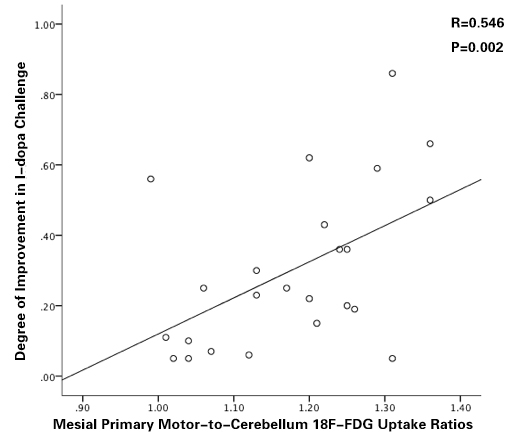Session Information
Date: Monday, October 8, 2018
Session Title: Parkinson's Disease: Neuroimaging And Neurophysiology
Session Time: 1:15pm-2:45pm
Location: Hall 3FG
Objective: We aim to explore if the degree of l-dopa responsiveness would be correlated to metabolism level in specific brain areas by using 18F-FDG and 11C-CFT of positron emission tomography (PET).
Background: People with Parkinson’s disease (PD) often suffer from tremor, bradykinesia and rigidity due to dopamine neuronal loss and impaired activities in supraspinal regions, including motor areas, basal ganglia, the thalamus, and the paracentral lobule. Nowadays, the dopamine replacement therapy is widely used to relieve these symptoms. However, the effects of l-dopa administration therapy vary a lot among different patients, which still lacks convincing explanation.
Methods: 29 participants with PD completed L-dopa challenge tests, in which each of them took 125 mg medopar and the effects induced by L-dopa were assessed by UPDRS-III. Then all the participants completed brain 18F- FDG and 11C-CFT PET imaging. Data of PET were realigned and spatially normalized into Montreal Neurological Institute (MNI) stereotactic space. Using region-of-interest-based analyses, we measured the ROI region-to-cerebellum uptake ratios in 9 brain areas.
Results: The Spearman correlation models demonstrated that: 1) the performance in the L-dopa challenge associated with the uptake of the of 18F-FDG in pallidum (p=0.031, r=0.402) (figure 1), supplementary motor area (p=0.009, r=0.478) (figure 2), mesial primary motor (p=0.002, r=0.546) (figure 3), and primary sensory areas. Those with greater improvement in L-dopa challenge had higher uptake in these regions. 2) The l-dopa responsiveness was also associated with the uptake of 11C-CFT in pallidum (p=0.029, r=0.398). Participants with greater responsiveness had higher uptake in pallidum.
Conclusions: These results suggest that fluorodeoxyglucose metabolism level and dopamine transporter availability correlated with different degrees of l-dopa responsiveness in patients with PD. The variance in treatment response may reflect the different damage degree in motor functional brain areas including pallidum and paracentral lobule.
References: 1. Frcs H A, Chengyuan Wu M D, Foltynie T, et al. l‐Dopa responsiveness is associated with distinctive connectivity patterns in advanced Parkinson’s disease[J]. Movement Disorders Official Journal of the Movement Disorder Society, 2017, 32(6):874. 2. Pavese N, Evans A H, Tai Y F, et al. Clinical correlates of levodopa-induced dopamine release in Parkinson disease: a PET study.[J]. Neurology, 2006, 67(9):1612-1617.
To cite this abstract in AMA style:
D. Su, W. Hu, X. Zhao, Z. Liu, H. Ma, J. Zhou, T. Feng. L-Dopa Responsiveness is Correlated to Fluorodeoxyglucose Metabolism and Dopamine Transporter Availability in Parkinson’s Disease [abstract]. Mov Disord. 2018; 33 (suppl 2). https://www.mdsabstracts.org/abstract/l-dopa-responsiveness-is-correlated-to-fluorodeoxyglucose-metabolism-and-dopamine-transporter-availability-in-parkinsons-disease/. Accessed December 25, 2025.« Back to 2018 International Congress
MDS Abstracts - https://www.mdsabstracts.org/abstract/l-dopa-responsiveness-is-correlated-to-fluorodeoxyglucose-metabolism-and-dopamine-transporter-availability-in-parkinsons-disease/



